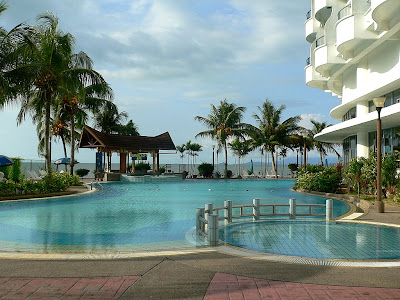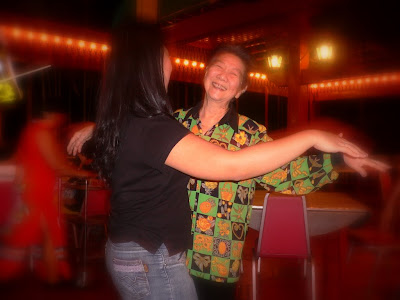Wednesday, March 12, 2008
Kuala Lumpur, Malaysia, 7-9 Mar 2008: Petronas Twin Towers
Dare To Dream
| In KL over the weekend of the Malaysian General Elections on 8th March. It is an unusually quiet and tense Saturday night. The ruling party BN goes on to lose 5 states, their heaviest loss in nearly 4 decades. A resounding nay to racial politics. Oblivious to the burgeoning tumult, we dine at the kitschy Saloma Bistro, Jalan Ampang, near the Petronas Towers. Stolidly statuesque in the daytime, the twin towers - joined by a skybridge - acquire a steely opalescence when lit at night. Almost too beautiful. Gazing at the towers, time stands still. Notwithstanding their controversial birth, these grand dames have become transfigured as iconic symbols of the capital. Perennial beacons. Solemn witnesses to the winds of change sweeping the peninsula. |
Labels: architecture, Kuala Lumpur, Malaysia
Sunday, November 25, 2007
Malaysia, Penang, 17-19 Nov 2007: Living With Thalassaemia
Drugs, Needles & Syringes
Thalassaemia is the commonest gene disorder in the world. In South-East Asia, about 1 in 20 persons carry the genes that can cause the disease. Thalassaemia major occurs when a child inherits affected genes from both parents, who may themselves be healthy carriers. A major thalassaemic suffers severe anaemia and requires The body is evolutionarily programmed to conserve iron: except for menstrual blood loss, there exists no physiological process to rid the body of excess iron. With regular blood transfusions, many major thalassemics survive childhood only to die from the complications of organ iron overload in their teens and young adulthood. Since the mid 1970s, the iron chelator desferrioxamine has been used to remove excess body iron in thalassaemia major. The drug, which induces negative body iron balance only if given continually throughout life, has to be administered subcutaneously for 8 to 12 hours, at least 5 nights a week. Patients typically start desferrioxamine injections from childhood. Nowadays, there are 2 other iron chelating drugs: deferiprone and deferasirox, both oral drugs. Deferiprone appears to be very good at eluting iron from heart muscle, especially when used in combination with desferrioxamine. A few patients develop dangerously low levels of white blood cells with the drug, which limits its use. Deferasirox is a new oral chelating agent with similar efficacy to parenteral desferrioxamine. It is forbiddingly expensive, and out of the economic reach of most thalassaemia major patients. The Penang Thalassaemia Society is a NGO that is dedicated to promoting the cause of thalassaemia patients in North Malaysia. The committee members comprises patients, parents, medical personnel and other volunteers. Through private charity, it has achieved remarkable success in funding expensive patient treatment: Penang I attended the 11th Penang Thalassaemia Camp on 17-18th Nov 2007, my second time in 2 years. The theme focused on compliance to iron chelation treatment. It was a humbling experience to watch the thalassaemia major patients perform their personal nightly ritual of desferrioxamine injection in a communal setting. For one child, it was the first time the parent learnt to prepare the desferrioxamine solution and inject the drug into the abdomen of the child. For another child, it was to be the first time she injected into herself. Alas, she could not do it at the last minute. Mummy did it for her that night, the nth thousandth time. There will always be tomorrow. |
Labels: friends, Malaysia, Penang, people
Sunday, April 08, 2007
Malaysia, Penang, 9-11 Sep 2006: Dancing And Dining
Sojourn With Friends
 I went on a short trip to Penang to deliver 2 talks to thalassaemia patients, parents, nurses and doctors about diagnosing iron overload in the heart. I went on a short trip to Penang to deliver 2 talks to thalassaemia patients, parents, nurses and doctors about diagnosing iron overload in the heart.I had a room at the Crown Prince Beach Hotel, Tanjung Bungah. The view from my room, especially at sunset, was achingly beautiful. |
 Penangnites are well known for their hospitality. On the second day, my new Penang friends drove me to Gurney Drive for afternoon merienda, and then later to Ferringhi Beach for a sumptuous seafood dinner. Penangnites are well known for their hospitality. On the second day, my new Penang friends drove me to Gurney Drive for afternoon merienda, and then later to Ferringhi Beach for a sumptuous seafood dinner.After dinner, there was some spirited dancing, Peranakan style. |
 On the last day, I had the choice of itinerary. I requested to go to Penang Road, for delicious chendol. You'd have to pay a little more to sit at the table in a nearby coffee shop to enjoy the chendol. They do a mean char kway teow too. On the last day, I had the choice of itinerary. I requested to go to Penang Road, for delicious chendol. You'd have to pay a little more to sit at the table in a nearby coffee shop to enjoy the chendol. They do a mean char kway teow too.The last time I tasted these was almost 10 years ago ... |
Labels: food, friends, Malaysia, Penang, people, sea

Licensed under Creative Commons Attribution-NonCommercial-NoDerivs 2.5 License

These are the 30 countries that I have ever set foot on. Airport stopovers don't count!
